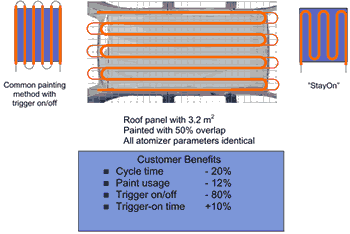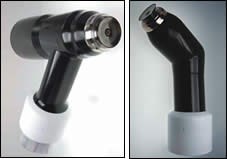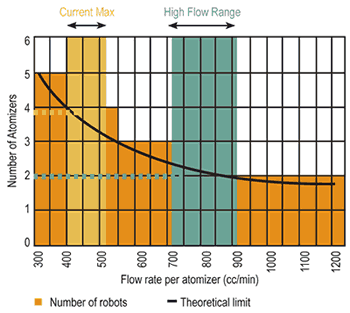Pumping Up Paint Productivity
Technology advances make robotic systems more cost-effective
#management
In today’s hyper-competitive business environment, robotic paint processes are being reshaped to offer users a wide variety of benefits, including more efficient coating application, reduced equipment requirements for application, and “greener” processes that can apply coatings safely, with less waste and power consumption.
When robotic coating automation was created in the 1960s, it was viewed as a way to replace men in existing systems with robots. And it worked very well to do that. A series of incremental improvements has driven robotic paint technology forward since then, and processes have continued to improve through the turn of the century to the point that extremely accurate finishes can be applied in an economical, safe and environmentally friendly manner. The standard robotic processes in use today are direct descendents of the systems that replaced painters in booths, with an independently designed robot, applicator, and spray booth system all working together at the highest possible quality and efficiency.
Featured Content
Incremental improvements are good, but a conscious effort must be made to make more significant advances. At ABB Robotics, we made the decision to create an R&D team that would start from scratch and try to do just that. As a manufacturer of robots, applicators and spray booths, our company was in a unique position to take such an approach.
We started by asking: What are the goals? What works, and what can be improved? There a many, many automated paint processes installed globally. ABB Inc. alone has an installed base of more than 10,000 painting robots.
Initial research would be targeted at improving the most common application of robotic painting—automotive auto body finishing. Automotive OEMs have a tradition of being first adopters of new robotic processes, and own approximately two-thirds of all robots.
What Works?
We began with a review of current processes and the capabilities of each portion of the paint process—paint finish, robot, and spray booth systems.
In terms of finish, current atomizer technology is extremely effective in applying coatings with high transfer efficiency, tight film-build tolerance, and excellent visual qualities. Today’s robots are more than robust and accurate enough to support atomizers in year-round painting systems in excess of 10 years operation, and modern spray booths are highly efficient at removing overspray and providing conditioned air required for Class A paint finish application.
What Can Be Improved?
So what are some factors limiting today’s robotic paint processes? On the finish front, spray cycle time is capped due to applicator pattern width and application arm speed. Bell atomizers traditionally have a standard fixed spray pattern width of approximately 10–12 inches, and this is the factor that limits how quickly a given area can be painted. Faster robot arm speed cannot improve cycle time because the physics of paint chemistry limits the bell applicator speed across the painted area to approximately 700 mm/sec.
Traditional robots are built in a manner to ‘stand’ where a man would have been. This adds to booth size and limits the reach of the robot. To increase usable reach, many robots are mounted on seventh-axis rails. This lengthens usable cycle time but also increases maintenance issues due to additional equipment in the spray booth environment.
Paint spray booths are one of the major consumers of energy in traditional auto assembly plants. Reducing the size of the booth is economically and environmentally responsible.
Increased Productivity
ABB Robotics set out to develop new atomizer, robot and booth technologies that would address the identified limitations of current systems. On the application front, we wanted to create a new bell atomizer specifically designed to work with a new robot. The new spray bell atomizer technology would have a high-volume, adjustable pattern width of from 6 to 18–20 inches maximum but would not sacrifice finish quality for a wider spray pattern. It would operate at speed of 70,000 rpm.
The new robot design would save space and at the same time provide more usable reach. It would be wall-mounted to reduce booth width, and be able to reach the front, side, rear and fully across the top of a standard-size vehicle. It would also use high-efficiency drives that would increase acceleration/deceleration rates while minimizing energy consumption.
For booths, the goal was to reduce booth width by at least 20% compared with a traditional process booth size. Width reduction equates directly to the amount of air to be conditioned, resulting in significantly reduced energy consumption. Savings cascade down to reductions in number of filters used, amount of water and water treatment chemicals used, amount of waste that requires disposal and permitting, and so on.
Paint Finish
The new bell atomizer is called the RB-1000. It can be used in two ways: For processes requiring few color changes, it can be fed via a traditional paint line. It’s also available in the Cartridge Bell System (CBS) for use in processes where reducing paint loss from multiple color changes is an issue.
The RB-1000 bell atomizer is capable of 1,000-cc output, 70,000 rpm, minimum spray pattern 6 inches in diameter and maximum spray pattern of 18–20 inches. Of course, these variables will adjust up or down according to unique paint chemistry. When used in CBS form, the bell can be used for both waterborne and solvent-borne paints due to isolation of voltage at the CBS.The CBS is a “green” application system that allows facilities to fill the precise amount of paint required to coat a car body or any part, minimizing the amount of paint wasted from changing colors. It is based on the simple concept of bringing paint as close as possible to the application and therefore creating a color change process that produces less waste. All the paint supply tubes are replaced with cartridges that contain the proper amount of paint for one car.
In essence, the robot sprays one color while the next paint cartridge is being filled. When the robot completes paint application of one color, it exchanges cartridges with the handler, minimizing the amount of paint that is flushed out of the system and treated as hazardous waste. The CBS system cartridge storage and refill rack is designed to work with existing paint circulation systems already feeding standard bells. This minimizes changes to existing circulation equipment.
The CBS system uses the robot controller, allowing equipment and processes to work together. Cartridge cleaning and filling stations are mounted on the booth wall. The integrated system fills the cartridges to be used by the bell mounted on the robot. The cartridge works like a syringe, with a “needle” (feed tube) that injects the paint just at the bell-cup level—the paint is never loaded in the atomizer. During a color change cycle, the bell-cup is cleaned and the cartridge is changed. Precise paint dosing is accomplished using a servomotor-driven system. The control system for the cartridge bell is fully integrated around a single robot controller, eliminating the need for multiple small controllers, communication links and interfaces.
The CBS was originally designed for ten or fewer colors in production, using dedicated cartridges for each color. In many markets, however, the number of color systems used in a production line is greater than what the initial design could cover. ABB addressed this problem by adding flushable cartridges. With this addition, the system evolved into a flexible solution that combines the original dedicated cartridge for high-runner colors and the flushable cartridges for low-runner colors.
Robot and Booth Design
The goal of the robot design team was to develop a spray system—not just a robot with a random applicator attached. The result was the IRB 5500 robot, which was designed with three major functions in mind:
- Reduce “patchwork” matching by reaching the entire vehicle body
- Support 1000-cc, large-pattern bell and provide “stay-on” part painting with rapid acceleration/deceleration
- Have a reduced footprint while increasing the robot’s useable envelope.
The new unit allows the robot arm to move completely across a car body without the need for patchwork with applicator patterns. In addition, this concept allows for long, horizontal strokes along the side of the car body, allowing users to develop more efficient robot motion programs and eliminating any potential vertical striping. Paint facilities are also left with cleaner applicators because they are no longer traveling into their own overspray.
The robot is designed specifically to carry the bell outlined earlier in this article, and the bell is designed to perform best at the speeds made possible by the robot’s improved acceleration/deceleration. Individually, these components offer great functionality. Together, they offer additional capabilities available only from such a “team” effort.
For example, the wider spray pattern available lets users reduce initial capital purchases as much as 50%. How? If spray pattern is twice the traditional width, spray cycle time is cut in half. Ideally, it will be possible to spray the same part, at the same line speed, with half the robots/applicators, if the large area spray pattern can be utilized.
Paint savings and accuracy are not compromised by using adjustable large pattern bells. The bell is still capable of reducing the pattern to 6 inches to perform delicate work such as door frame cut-in or A pillar application, minimizing wasteful overspray associated with fixed-pattern bells spraying very large patterns. Equipment purchases can be further reduced and commonized because the wall-mounted robot can reach the sides as well as the top of a vehicle. A traditional system would require a small robot to reach the side and a large robot to reach across the top of the vehicle.
Together, the robot and application equipment can perform processes that reduce overspray while increasing usable spray cycle time. This is a method of painting ABB describes as “Stay On.” In the past, the robot had to carry the atomizer past the edge of the part, do a U-turn and return onto the part to continue spraying. Paint pathing was developed this way so that humps and/or lumps of paint did not result from trying to perform a U-turn on the part.
Moving off the part and back on worked fine, but the user suffered a penalty in cycle time and overspray paint waste. Now, with acceleration/deceleration rates that can support a U-turn on part while spraying and still stay within film build tolerances, the user gets both increased throughput and reduced waste while maintaining user film specifications.
Use of such fast, flexible robots also results in the ability to use smaller booths for a given robot reach. Spray booths are notoriously large users of energy due to the tight temperature and humidity controls many of today’s high-end paint chemistries require. Using new robotic equipment can equate to as much as a 20% reduction in booth width.
Results
Automotive OEMs have a reputation for performing extreme due diligence when reviewing new automated paint processes that will need to operate around the clock. Given this, the auto industry has been surprisingly quick to embrace the capabilities described here. So far five major automotive OEMs have installed or are installing this process in their facilities—surprisingly fast adoption, considering this technology was introduced to the public less than 24 months ago.
For example, one automaker, looking to extend a spray booth to put in a typical robotic spray system, is instead working with ABB to implement the technologies described here. Instead of unnecessarily enlarging the customer’s booth, ABB installed IRB 5500 robots into the existing spray booth. This saved substantial capital expenditure by eliminating the need to extend the spray booth an additional four meters and eliminating the need for a proposed rail system. It also saves energy and maintenance costs by doing away with the additional booth length. The new system thus reduces initial capital cost, and allows removal of two robots and applicators can also be removed from the installation.
But what about users in general industry? Although the technological advances outlined here are aimed primarily at automotive OEMs, other types of customers are reviewing their new equipment options and continuing to find new and unique uses for these robot/atomizer combinations.
For example, a robot such as the IRB 5500 can be extremely useful in open face booths painting large products. Traditionally, users of this type of booth configuration have tried to mount a robot on some sort of sliding table so the booth can still be used as a manual spray station when the robot is pushed out of the way.
Now the robot can be mounted high on the sidewall, tuck itself away when not in use and deploy when high-production parts are in the booth to be painted. No tracks, trenches, or other devices impede access to the booth.
This style of robot lends itself to painting a variety of large components front, top and bottom. An example is large engines or motors for power generation or earth moving equipment. The unique work envelope also lends itself to painting odd shapes such as large satellite dishes, large fiberglass/plastic moldings, cell phones, hot tubs and so on.
Paint automation technology has not gone not stale. As it continues to move forward, there are advantages to reviewing new equipment.
RELATED CONTENT
-
Valence Surface Technologies Sold to Investment Groups
ATL Partners and British Columbia Investment Management purchase Texas-based Valence.
-
Dear Valued Supplier
"Dear valued supplier," the letter begins.
-
Managing Stacked Tolerances with PTFE Lubricants
PTFE coatings allow surgical instruments to overcome static friction.






















